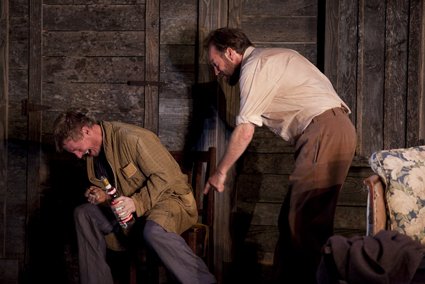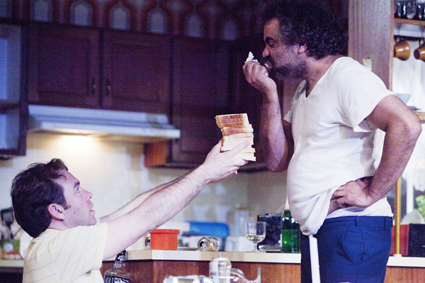cross-cultural winners
keith gallasch: stc, uncle vanya, true west

Richard Roxburgh, Hugo Weaving, Uncle Vanya
photo © Lisa Tomasetti, 2010
Richard Roxburgh, Hugo Weaving, Uncle Vanya
THE SYDNEY THEATRE COMPANY PRODUCTION OF ANTON CHEKHOV’S UNCLE VANYA LAYERS A PATINA OF THE ACCENT AND LIGHT OF MID-20TH CENTURY RURAL AUSTRALIA OVER THE PLAY’S LATE-19TH CENTURY RUSSIAN SETTING. ITS PRODUCTION OF SAM SHEPARD’S TRUE WEST, PLAYED BY AUSTRALIAN ACTORS, ONE OF THEM INDIGENOUS, IS RIGOROUSLY AMERICAN IN VOICE AND EMBODIMENT. UNCLE VANYA IS DIRECTED BY A HUNGARIAN, TRUE WEST BY AN AMERICAN. CROSS-CULTURAL COLLABORATIONS AND FIDELITY TO TEXTS HAVE YIELDED MORE THAN MERELY MEMORABLE THEATRE.
In each production a pair of superb male performances, Hugo Weaving and Richard Roxburgh in Uncle Vanya, Wayne Blair and Brendan Cowell in True West, provides the volatile dynamic that unleashes new realms of feeling and insight.
uncle vanya
In the beginning, harsh sunlight glares into a huge barn of a room, flies buzz persistently, a worker in the distance chops wood. At the play’s end, the walls have closed in, the light dimmed and cut logs fall through an open door as if in readiness for the internal exile imposed by the coming winter. In the meantime relationships have unravelled to the point of violence. Talk for talk’s sake, denial and alcoholic release have failed to veil the disappointments of love and ideals unrealised.
Central to Tamas Ascher’s direction, as it was in his Ivanov for the 2009 Sydney Festival, is a superb sense of rhythmic momentum: stillness followed by sudden propulsion, outbursts, reflection, dancing, subtle personal moves (Yelena’s hand momentarily on Vanya’s), household comings and goings and obstructions—a large door that comes to symbolise emotional barriers. These alternations are embodied in the performers’ characterisations: the doctor, Astrov (Hugo Weaving), energetically and loquaciously idealistic, immediately has an eager- to-dance bounce in his loping step. Richard Roxburgh’s Vanya is awkward, restive, his clothes don’t fit and his hair sticks out at odd angles—it’s as if he’s just got out of bed and is trying to make sense of a world with which he is out of step, making him all the more frightening when he moves, gun in hand, with the energy of a killer.
Cate Blanchett’s Yelena is, as one of the characters sarcastically puts it, “a sleek, beautiful ferret,” elegant, 1950s stylish. She attempts to move smoothly through the irruptions created by her husband’s self-pity, Vanya’s advances and Astrov’s attractiveness, her self-contained rhythm only broken temporarily in a bout of loose-limbed, tipsy playfulness with her step-daughter, Sonya (Hayley McElhinney), or in a desperate, passionate embrace with the doctor. Elsewhere her empathy for Vanya and Sonya can’t be allowed to get in the way of a necessary obtuseness that goes with a protected, if loveless, life with her wealthy husband, Serebyakov (John Bell). Sonya, on the other hand, is stolid and pragmatic, her stabilising presence and her physical assuredness soon undone by her passion for Astrov, as is the comforting rhythm of managing farm life with Vanya.
What is striking about Ascher’s account of the play is his perfect balancing of tedium and tension with immediacy and viscerality—when Vanya sees Astrov and Yelena embracing, he is like a man winded; when Yelena is exhausted by Vanya’s courting she slumps from the waist almost to the floor; when Vanya and Astrov dance it is almost dangerous; even the hypochondriacal Serebyakov confined to his chair bristles with an explosive nervous energy. These are not people living in a reverie of hope and despair or slow-motion rural life; body and soul they face a crisis. And although their jobs, their roles remain the same, we have seen them change, learn, suffer—Sonya’s first yearning for love, Yelena’s glimpse of love with Astrov, Vanya’s knowledge that he is unloved, the death of friendship between Vanya and Astrov. Life will go on as before but, equally, will not.
Performances overall are excellent, vividly detailed and constantly surprising. Roxburgh and Weaving together constitute the production’s greatest strength, partly because their joint dynamic is embodied in the writing—these friends are emotional and philosophical opposites and their shared attraction to Yelena the thread around which much of the play is delicately woven. In performance, the actors’ characterisations are idiosyncratic, contrastive but compatible, and each has a particular energy, emotional and physical—Roxburgh’s fascinatingly lateral, Weaving’s forthright. This is felt right to the end when Astrov has to retrieve the stolen morphine with which Vanya might suicide.
Andrew Upton’s adaptation is lucid, the language unlaboured, unadorned (effectively homing in on a few key words like “disgusting” and “nothing”) and peppered with just enough of the vernacular in the mouths of the minor characters to make sense of the unforced cultural transposition.
Ascher’s Ivanov for the Sydney Festival in 2009 located that earlier Chekhov work in 1960s Hungary (the effect, both seductive and disturbing, as I mentioned at the time [RT89], was not unlike watching one of Czech director Milos Forman’s 60s films). With its broader, less centred social palette and Ascher’s large company, Ivanov allowed for radical stage invention and an acute sense of analogies drawn between different eras. The STC-Ascher Uncle Vanya is much more restrained in its transposition; doubtless the play’s tighter structure left little room for anything more than Australian ambience in sound, light, occasional diction alongside uncluttered, un-rhetorical contemporary playing. Chekhov’s ecological sensitivity voiced by Astrov, still feels starkly contemporary. This surprised some in the audience who suspected adaptor Andrew Upton of updating the play because the STC has just gone seriously green at its Wharf venue (www.sydneytheatre.com.au/visit/greening-the-wharf).

Brendan Cowell, Wayne Blair, True West, Sydney Theatre Company
photo Brett Boardman
Brendan Cowell, Wayne Blair, True West, Sydney Theatre Company
true west
A suburban home outside Los Angeles: kitchen, pot-plants, a writer at work, someone standing in the dark behind him. The sense of threat is immediate (the set thrusts out almost into the audience) and is sustained throughout American actor and director Philip Seymour Hoffman’s account of Sam Shepard’s True West.
The threat develops an increasingly delirious edge as the renegade desert-dweller Lee (Wayne Blair) takes over the life of his screenplay writer brother Austin (Brendan Cowell), goading him into crime (Austin opts for the non-violence of stealing toasters), usurping Austin’s contract with a producer so that he can get his ‘true’ western made, and forcing Austin to help him script it (“I want to do it myself…just help me get the talking right”). Lee, however, becomes preoccupied with the very art he has hitherto viciously derided (“What? You’re paid to dream?”) while Austin begins to reject anything that will compromise his integrity as a writer. He declares there is no true West (the streets of his childhood now look to him like replicas) and grows seemingly insane, but appears, at the very least, to be his own man. Art becomes too much for Lee who decides to return to the desert, despite having admitted that it has never constituted freedom so much as a refuge from the punishing suburban life that rendered him an outsider in the first place.
Shepard, like his near contemporary Harold Pinter, generates menace by creating in Lee a master manipulator who uses the ambiguities of language to trap his less verbally skilled prey with skewed logic and rhythmically forceful delivery. Lee’s aggression is compounded by physical threat, driving Austin to hide ineffectively amidst the pot-plants and to reluctantly comply with his wishes. Lee likewise repeatedly smashes the typewriter that will not yield the words he wants and, with Austin, eventually trashes their mother’s home as their joint reality becomes increasingly unhinged.
Blair’s Lee speaks with an almost movie-gangsterish growl, occupies space as if it was his alone, moves suddenly from sheer stillness into attack mode, and, most frighteningly, in his moments of revelation, stares wide-eyed into the distance as a prelude to some act of nastiness. Cowell’s Austin is tight, hands kept close to the body, his speech and walk neat, verging on fey. As the role reversal unfolds, Austin manically asserting himself (making a mountain of toast) and Lee rattled by the demands of art, the mood and body language changes: Austin becomes the threatening, psychotic presence. Blair and Cowell execute the reversal expertly, on the way adroitly playing out the episodes Shepard binds to riffing arguments about Idaho plates, art, golf, movie car chases and scriptwriting (a rare moment of hilarious unanimity over the rightness of, “I’m on intimate terms with this prairie”).
Wayne Blair, Brendan Cowell and Phillip Seymour Hoffman have finely realised True West’s raw, scary, scintillating portrait of brotherhood—loveless, intimidating and, finally, deadly, revealing how exclusion, the broken family and (as the nearest-to-hand excuse for Lee) Hollywood-fuelled creative ambitions can combine explosively. True West is a further step in STC’s welcome engagement with American theatre, its plays and its artists, while the invitation to Tamas Ascher to direct Uncle Vanya has proven to be even more cross-culturally inspired.
Sydney Theatre Company: Uncle Vanya, writer Anton Chekhov, director Tamas Ascher, performers Richard Roxburgh, Hugo Weaving, Cate Blanchett, John Bell, Hayley McElhinney, Sandy Gore, Anthony Phelan, Jackie Weaver, Andrew Tighe, designer Zsolt Khell, lighting Nick Schlieper, composer/sound designer Paul Charlier; Sydney Theatre, opened Nov 13; True West, writer Sam Shepard, director Philip Seymour Hoffman, performers Wayne Blair, Brendan Cowell, Alan Dukes, Heather Mitchell, designer Richard Roberts, lighting Paul Jackson, composer, sound designer Max Lyandvert; Wharf 1, STC, Sydney, opened Nov 2
RealTime issue #100 Dec-Jan 2010 pg. 36






